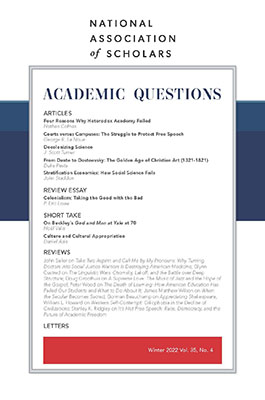Daniel Asia is an American composer whose work ranges from solo pieces to large scale multimovement works for orchestra and includes six symphonies. Since 1988, Asia has been Professor of Composition and head of the composition department at the University of Arizona in Tucson; [email protected]. He wrote “In Honor of Roger Scruton: Reflections on Beauty and Photography,” for our Fall 2022 issue.
Cultural appropriation refers to a dominant culture’s use or adoption of the forms and identifying characteristics of a minority culture. The process of doing so is now considered disrespectful and harmful to the minority culture regardless of the dominant culture’s intentions, even if they were originally innocuous or rooted in admiration. In this transaction, the notion of seizing or stealing (i.e., “appropriating,” “colonizing”) is universally considered wrong. So, to the extent that cultural appropriation is a disputed concept, it is the term “culture” that is the crux of the issue. What do we even mean when we speak of culture? And why is it so egregious for a “dominant” culture to utilize the forms and features of another?
Culture may be used as a term to define many of the attributes of any society. It generally references a society’s values, customs, artifacts, and collective beliefs. Culture includes the nature of its government, such as democratic or totalitarian, that may then affect not just governmental institutions, but how schools or workplaces function as well. One might expect the former to be more inclusive and broader in representation, with the latter less inclusive and more hierarchical.
We could use the term “visual culture” to define differences before and after the introduction of camera phones and social media, and the ubiquitous nature of images in our lives. One need only think of billboards, placards, posters, signs of all kinds (replacing images of a business’s actual product: fruit for a fruit and vegetable shop, glasses for the purveyor of new frames and lenses, etc., when the vast majority of a population was illiterate). The term is also used as an adjective, rather than as a noun, as in cultural economics, in this case economic practices such as free enterprise, a controlled economy, or institutions such as box stores or social media.
Culture is also used to describe the arts. Visual art, music, dance, and theater might be considered a primary area of what is often just called “Culture.” This culture is formed of those who create it, those who recreate it, and those who witness it. It is formed of two types, artifacts and performances, according to the anthropologist and philosopher Dennis Dutton. With visual art, the artist creates mostly the artifacts of paintings and sculpture, although now we might wish to include photography, film, conceptual art, architecture, performance art, etc. The artistic artifact is then seen by the viewer. It may or may not have an economic value, which may be determined by considerations of size, appropriateness for a particular space, how well it realized the artist’s intentions, and ultimately its aesthetic qualities, which are often only realized or understood long after the work has been created.
Performances are, of course, just that: the realization of a work that does not exist until performers or actors bring it to life. This applies to music and theater, wherein the pianist realizes or brings to life all the components of the musical score—including pitches and rhythms, dynamics and articulation—into vibrations that then travel and are “caught” by the listener’s ear and brain. The same occurs when the actor brings into the written play matters of tone, pacing or speed, and emphasis of particular words in the delivery of lines. There is also the interpretive element provided by bodily movement, as when the pianist moves on his stool, the movement of body and arms, the actor’s placement or traversal on the stage, his interaction with all the other actors, or his relative distance from the audience.
Culture, in its artistic conception, may be thought of as high (classical; traditional) or low (popular; vernacular). The difference here has to do with whether the artifact contains more or less information, is elevated or kitschy in terms of quality and meaning, presents deep or trivial ideas, or whether it simply provides entertainment versus presenting a certain high-minded experience. High culture in this regard can be thought of as the best that humans have created over time in these artistic domains. Thus, for Matthew Arnold it is the “the study of perfection,” and “sweetness and light.” For Albert Murray it is distinguished from the folk or popular because “[f]olk expression is nothing if not conventional in the most fundamental sense of the word.” It is concerned with maintaining standards and is derivative. It is representative of the people. High culture, or what we can now just call artistic culture, as Hemingway said, is art that is
only done by the individual . . . the individual, the great artist when he comes, uses everything that has been discovered or known about his art up to that point . . . He takes instantly what it takes the ordinary man a lifetime to know and then the great artist goes beyond what has been done or known and makes something of his own.
How then might we understand cultural appropriation? At its basest level, this term presents the notion that to borrow something from another culture of which you are not a part is loathsome, and denigrates the borrowed culture. Is this so, or is it a matter of intent, a matter of the heart? Were the students of Yale University who wore Mexican garb for Halloween committing an unpardonable offense against Mexican culture and its people? The highly regarded University of Michigan composer Bright Sheng, survivor of Mao’s Cultural Revolution, was recently criticized and almost cancelled as a result of showing in class a performance of Othello with Sir Laurence Olivier in black face, not an unusual practice when the picture was made in 1965. Was Olivier, or his director, bringing a racist perspective to the part, or one of verisimilitude? This has also been a traditional practice in the opera world. Is it a denigration of blacks or Moors in Verdi’s Otello, or a denigration of Chinese and the opera Madama Butterfly’s lead character Cio-Cio-San, if make-up artists do their job and make singers look more like the characters they are playing?
Virtually all artistic or high culture involves appropriation from someone, something, or somewhere. The artist appropriates from his teacher’s knowledge. He appropriates from everything he has heard or seen that in any way affects his vision of the world and that therefore affects his art, as any artist is the sum of his experience. In other words, appropriation cannot be separated from learning and intellectual growth; it is as basic to existence as is eating and sleeping; it is a primary function of being, and of being human.
For the arts, it is important to point out that making cultural distinctions does not imply that Western culture is dominant and non-Western cultures are inferior. That is a political distinction being promulgated by those who seek to denigrate the former on behalf of the latter, and by those who in so doing, use non-Western cultures to advance their own political ends. That is the real appropriation taking place.
The history of the world is one that has seen artistic and cultural influences cross deserts and oceans. Music, art, religion, science, language, and food, all progress thanks to the cultural ebb and flow of human enthusiasms and inspirations. Ultimately, the process is one not of theft, but of admiration and respect.
Photo by Boston Public Library on Unsplash












